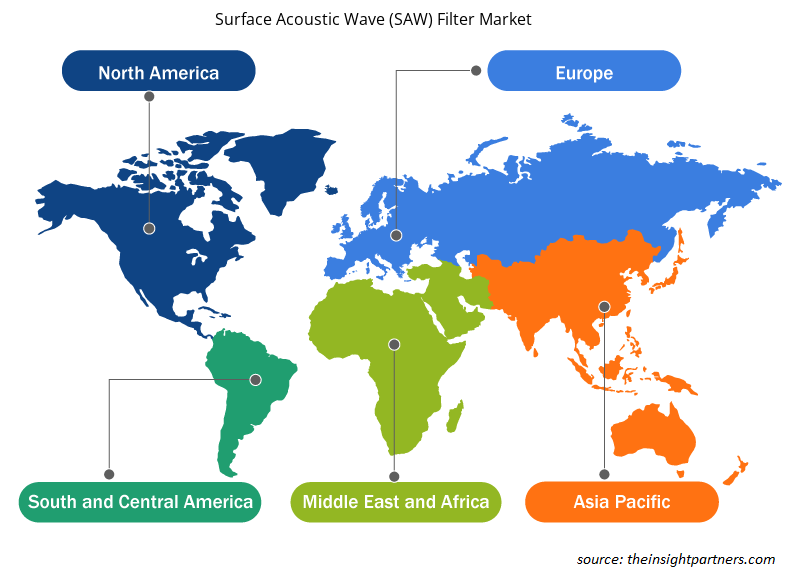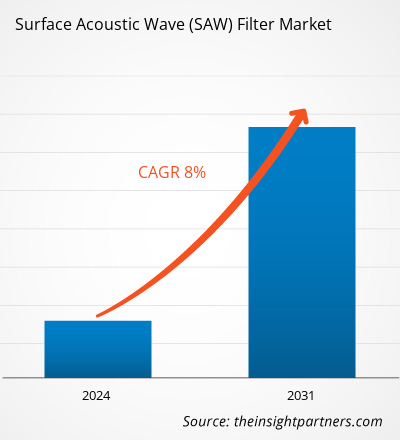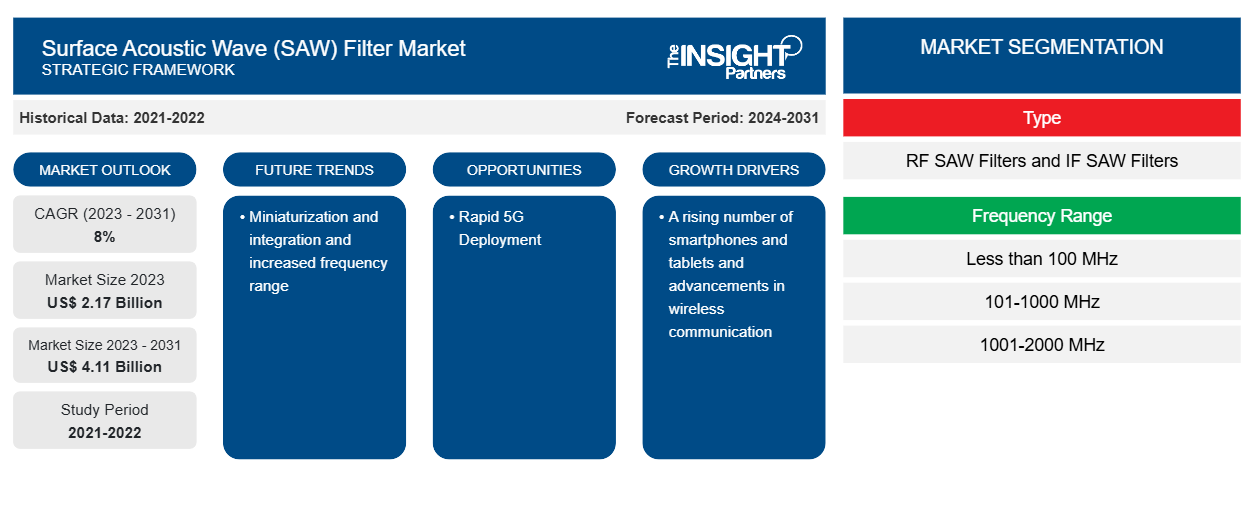Si prevede che la dimensione del mercato dei filtri a onde acustiche di superficie (SAW) raggiungerà i 4,11 miliardi di dollari entro il 2031, rispetto ai 2,17 miliardi di dollari del 2023. Si prevede che il mercato registrerà un CAGR dell'8,0% nel periodo 2023-2031. La miniaturizzazione, l'integrazione e l'aumento della gamma di frequenza rimarranno probabilmente una tendenza chiave nel mercato.CAGR of 8.0% during 2023–2031. Miniaturization and integration and increased frequency range are likely to remain a key trend in the market.
Analisi di mercato dei filtri per onde acustiche superficiali (SAW)
La classe più popolare di filtri SAW è ampiamente utilizzata nei sistemi TV e radio residenziali, comprese le stazioni base e gli apparecchi telefonici mobili. Esistono numerose varietà, ciascuna con un set unico di vantaggi, tra cui dimensioni ridotte, funzionamento ad alta frequenza, perdita di inserzione minima e basso fattore di forma. L'estrema precisione con cui è possibile formare forme quasi illimitate sulla superficie rende concepibile un'ampia gamma di tipi.
Panoramica del mercato dei filtri per onde acustiche superficiali (SAW)
I filtri per onde acustiche di superficie sono stati una parte importante dei televisori digitali e dei telefoni cellulari. In ogni smartphone e altro dispositivo IoT device , i filtri SAW rimangono un componente cruciale del modulo di comunicazione. La tecnologia SAW fornisce soluzioni convenienti per molti tipi diversi di utilizzo. I componenti SAW sono un'opzione migliore per un cliente che ha bisogno di una produzione su larga scala grazie al loro prezzo accessibile. Il tempo di sviluppo dei componenti SAW è ridotto a poche settimane grazie a sofisticati strumenti di simulazione e ai più recenti progressi nella tecnologia dei processi dei semiconduttori.
Personalizza questo report in base alle tue esigenze
Riceverai la personalizzazione gratuita di qualsiasi report, comprese parti di questo report, o analisi a livello nazionale, pacchetto dati Excel, oltre a usufruire di grandi offerte e sconti per start-up e università
-
Scopri le principali tendenze di mercato in questo rapporto.Questo campione GRATUITO includerà analisi di dati che spaziano dalle tendenze di mercato alle stime e alle previsioni.
Driver e opportunità di mercato per i filtri a onde acustiche di superficie (SAW)
Aumento del numero di smartphone e tablet per favorire il mercato
I filtri SAW sono ancora una parte importante di qualsiasi smartphone, essendo stati utilizzati dai produttori per molti anni sin dalla prima generazione di telefoni cellulari. Dal lancio di LTE, un'ampia gamma di bande di radiofrequenza, o bande LTE, da 600 MHz a 2700 MHz, è stata supportata dagli smartphone. Per garantire la compatibilità di rete globale, i produttori di smartphone incorporano la maggior parte delle bande LTE che vengono spesso utilizzate. La larghezza di banda inferiore a 6 GHz è stata resa disponibile dal 5G per le implementazioni precedenti e i filtri SAW sono in grado di catturare la maggior parte delle frequenze di banda inferiore. Le soluzioni di filtro SAW forniscono duplexer e multiplexer ad alte prestazioni per i moduli di comunicazione RF che alimentano i dispositivi mobili contemporanei. A livello globale, l'uso degli smartphone è quasi universale nei paesi industrializzati. Secondo stime del 2023, ci sono attualmente più di 6,5 miliardi di smartphone in uso in tutto il mondo e si prevede che questa cifra aumenterà negli anni a venire. Ciò guiderà la domanda nel mercato dei filtri a onde acustiche di superficie (SAW).LTE, a wide range of radio frequency bands, or LTE bands, from 600MHz to 2700MHz, have been supported by smartphones. In order to ensure global network compatibility, smartphone manufacturers incorporate the majority of LTE bands that are often used. Sub-6GHz bandwidth was made available by 5G for earlier deployments, and SAW filters are capable of capturing the majority of lower-band frequencies. SAW filter solutions provide high-performance duplexers and multiplexers for RF communication modules that power contemporary mobile devices. Globally,
Rapida distribuzione del 5G
La necessità di filtri SAW è guidata dall'introduzione della tecnologia 5G e dall'espansione dei dispositivi Internet of Things (IoT). Un filtraggio preciso è necessario affinché queste applicazioni funzionino in ambienti radio complicati. L'obiettivo della ricerca in corso è di ridurre ulteriormente le dimensioni dei filtri SAW in modo che possano essere inseriti in dispositivi elettronici progressivamente più piccoli senza sacrificare la funzionalità. Sono inoltre in corso sforzi per ridurre i costi di produzione e migliorare le prestazioni integrando i filtri SAW con altre parti su un singolo chip.IoT) devices. Precise filtering is necessary for these applications to operate in complicated radio environments. The goal of ongoing research is to further reduce the size of SAW filters so they can fit into progressively smaller electronic devices without sacrificing functionality. Efforts are also underway to lower production costs and enhance performance by integrating SAW filters with other parts on a single chip.
Analisi della segmentazione del rapporto di mercato del filtro per onde acustiche superficiali (SAW)
I segmenti chiave che hanno contribuito alla derivazione dell'analisi di mercato dei filtri SAW (Surface Acoustic Wave) sono tipologia, gamma di frequenza e applicazione.
- In base al tipo, il mercato dei filtri a onde acustiche di superficie (SAW) è suddiviso in filtri RF SAW e filtri IF SAW. Il segmento dei filtri RF SAW ha detenuto la quota maggiore nel 2023.
- In base alla gamma di frequenza, il mercato è suddiviso in meno di 100 MHz, 101-1000 MHz, 1001-2000 MHz e più di 2000 MHz.
- In base all'applicazione, il mercato è suddiviso in elettronica di consumo, automotive, aerospaziale e difesa, telecomunicazioni e altri.
Analisi della quota di mercato dei filtri per onde acustiche superficiali (SAW) per area geografica
L'ambito geografico del rapporto sul mercato dei filtri a onde acustiche di superficie (SAW) è suddiviso principalmente in cinque regioni: Nord America, Asia Pacifico, Europa, Medio Oriente e Africa, e Sud e Centro America.
L'Asia Pacifica detiene una quota significativa del mercato dei filtri a onde acustiche di superficie (SAW) nel 2023. L'Asia Pacifica è il polo produttivo per l'industria dei semiconduttori. Paesi come Corea del Sud, Giappone e Cina sono importanti hub di produzione di semiconduttori. Inoltre, la regione ha un numero significativo di produttori di smartphone che guidano la domanda di filtri SAW nella regione.
Approfondimenti regionali sul mercato dei filtri per onde acustiche superficiali (SAW)
Le tendenze regionali e i fattori che influenzano il mercato dei filtri a onde acustiche di superficie (SAW) durante il periodo di previsione sono stati ampiamente spiegati dagli analisti di Insight Partners. Questa sezione discute anche i segmenti del mercato dei filtri a onde acustiche di superficie (SAW) e la geografia in Nord America, Europa, Asia Pacifico, Medio Oriente e Africa e Sud e Centro America.

- Ottieni i dati specifici regionali per il mercato dei filtri per onde acustiche di superficie (SAW)
Ambito del rapporto di mercato sui filtri a onde acustiche di superficie (SAW)
| Attributo del report | Dettagli |
|---|---|
| Dimensioni del mercato nel 2023 | 2,17 miliardi di dollari USA |
| Dimensioni del mercato entro il 2031 | 4,11 miliardi di dollari USA |
| CAGR globale (2023-2031) | 8% |
| Dati storici | 2021-2022 |
| Periodo di previsione | 2024-2031 |
| Segmenti coperti |
Per tipo
|
| Regioni e Paesi coperti |
America del Nord
|
| Leader di mercato e profili aziendali chiave |
|
Densità dei player del mercato dei filtri per onde acustiche di superficie (SAW): comprendere il suo impatto sulle dinamiche aziendali
Il mercato dei filtri a onde acustiche superficiali (SAW) sta crescendo rapidamente, spinto dalla crescente domanda degli utenti finali dovuta a fattori quali l'evoluzione delle preferenze dei consumatori, i progressi tecnologici e una maggiore consapevolezza dei vantaggi del prodotto. Con l'aumento della domanda, le aziende stanno ampliando le loro offerte, innovando per soddisfare le esigenze dei consumatori e capitalizzando sulle tendenze emergenti, il che alimenta ulteriormente la crescita del mercato.
La densità degli operatori di mercato si riferisce alla distribuzione di aziende o società che operano in un particolare mercato o settore. Indica quanti concorrenti (operatori di mercato) sono presenti in un dato spazio di mercato in relazione alle sue dimensioni o al valore di mercato totale.
Le principali aziende che operano nel mercato dei filtri a onde acustiche di superficie (SAW) sono:
- Murata Manufacturing Co., Ltd.
- API Technologies (UK) Ltd.
- Abracon
- Qualcomm Technologies, Inc.
- Qorvo, Inc.
- Soluzioni Skywork, Inc.
Disclaimer : le aziende elencate sopra non sono classificate secondo un ordine particolare.

- Ottieni una panoramica dei principali attori del mercato dei filtri per onde acustiche di superficie (SAW)
Notizie di mercato e sviluppi recenti sui filtri a onde acustiche di superficie (SAW)
Il mercato dei filtri a onde acustiche di superficie (SAW) viene valutato raccogliendo dati qualitativi e quantitativi dopo la ricerca primaria e secondaria, che include importanti pubblicazioni aziendali, dati di associazioni e database. Di seguito sono elencati alcuni degli sviluppi nel mercato dei filtri a onde acustiche di superficie (SAW):
- Murata Manufacturing Co., Ltd. (sede centrale: Nagaokakyo-shi, Kyoto; Presidente del Consiglio di Amministrazione e Presidente: Tsuneo Murata) ha sviluppato e avviato la produzione in serie dei duplexer SAW*2*3 più piccoli*1 al mondo: le serie SAYAV, SAYARV e SAYAP; e dei filtri SAW: la serie SAFFW (di seguito "i Prodotti"). (Fonte: Murata Manufacturing Co., Ltd., Comunicato stampa, luglio 2019)
- Qualcomm Technologies, Inc. ha introdotto una nuova generazione di tecnologia di microfiltro acustico che amplia il nostro portafoglio RF front-end (RFFE) e apre le porte a nuovi servizi e applicazioni 5G. (Fonte: Qualcomm Technologies, Inc, comunicato stampa, ottobre 2021)
Copertura e risultati del rapporto di mercato sui filtri a onde acustiche di superficie (SAW)
Il rapporto "Dimensioni e previsioni del mercato dei filtri per onde acustiche di superficie (SAW) (2021-2031)" fornisce un'analisi dettagliata del mercato che copre le seguenti aree:
- Dimensioni e previsioni del mercato dei filtri per onde acustiche di superficie (SAW) a livello globale, regionale e nazionale per tutti i principali segmenti di mercato coperti dall'ambito
- Tendenze del mercato dei filtri a onde acustiche di superficie (SAW), nonché dinamiche di mercato quali driver, vincoli e opportunità chiave
- Analisi dettagliata delle cinque forze PEST/Porter e SWOT
- Analisi di mercato dei filtri per onde acustiche di superficie (SAW) che copre le principali tendenze di mercato, il quadro globale e regionale, i principali attori, le normative e i recenti sviluppi del mercato
- Analisi del panorama industriale e della concorrenza che copre la concentrazione del mercato, l'analisi della mappa di calore, i principali attori e gli sviluppi recenti per il mercato dei filtri a onde acustiche di superficie (SAW)
- Profili aziendali dettagliati
- Analisi storica (2 anni), anno base, previsione (7 anni) con CAGR
- Analisi PEST e SWOT
- Valore/volume delle dimensioni del mercato - Globale, Regionale, Nazionale
- Industria e panorama competitivo
- Set di dati Excel
Report recenti
Testimonianze
Motivo dell'acquisto
- Processo decisionale informato
- Comprensione delle dinamiche di mercato
- Analisi competitiva
- Analisi dei clienti
- Previsioni di mercato
- Mitigazione del rischio
- Pianificazione strategica
- Giustificazione degli investimenti
- Identificazione dei mercati emergenti
- Miglioramento delle strategie di marketing
- Aumento dell'efficienza operativa
- Allineamento alle tendenze normative























 Ottieni un campione gratuito per - Mercato dei filtri a onde acustiche di superficie (SAW)
Ottieni un campione gratuito per - Mercato dei filtri a onde acustiche di superficie (SAW)